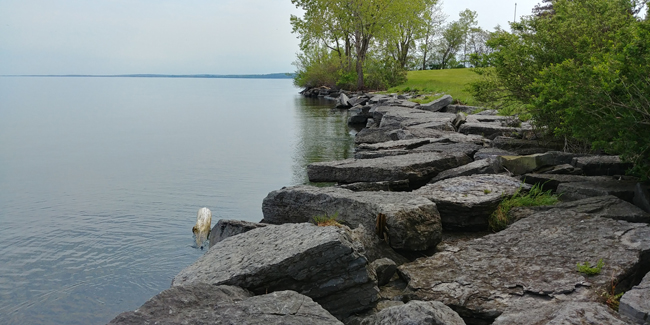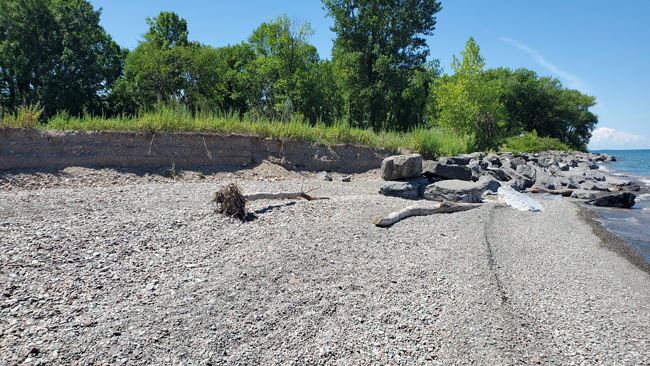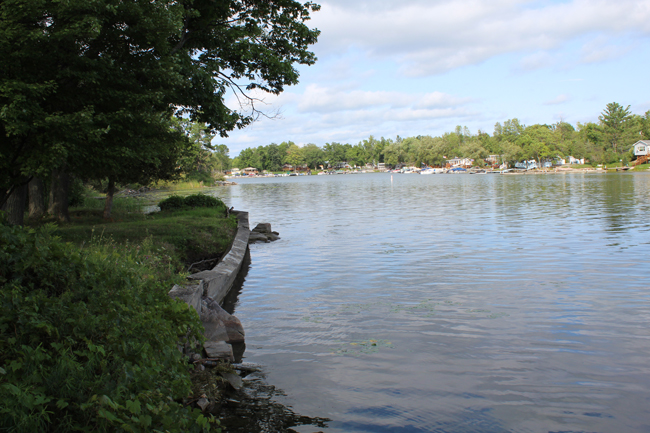
This rock rip-rap wall was installed to prevent shoreline erosion. Incorporating additional nature-based methods would improve stability of the wall to withstand storm waves along Lake Ontario at Mexico, N.Y. Credit: New York Sea Grant/Roy L. Widrig
Sea Grant Offers How-To Expertise, Guidebook, Virtual Site Visits, Contractor List
Contacts:
Roy Widrig, New York Sea Grant Coastal Processes and Hazards Specialist, E: rlw294@cornell.edu, P: 315-312-3042
Kara Lynn Dunn, Great Lakes Freelance Publicist, NYSG, E: karalynn@gisco.net, P: 315-465-7578
Oswego, NY, September 30, 2020 - The fall season is an ideal time to evaluate shoreline properties along New York’s Great Lakes for areas impacted by the natural dynamic action of the Lakes.
New York Sea Grant is providing property owners with virtually-available resources and assistance that includes:
- a guide to Erosion Management for New York’s Great Lakes Shorelines;
- a virtual access portal at www.nyseagrant.org/glcoastalvirtualsitevisit, where property owners can upload photos of areas of erosion, wave action, and flooding on Lake Erie and Lake Ontario for evaluation and advice by New York Sea Grant (NYSG) Great Lakes Coastal Processes and Hazards Specialist Roy Widrig, author of the Erosion Management for New York’s Great Lakes Shorelines Guide. There is no cost for the review;
- an updated list of contractors available for shoreline erosion project work in New York’s Great Lakes region and guidelines for how to select a shoreline project contractor; and
- several publications on coastal erosion processes and impacts, living shorelines, and manmade structures for erosion management.
“There is a full array of protection options that can be applied to address shoreline integrity issues. Each property, however, is a unique situation and these resources from New York Sea Grant help property owners and managers determine which option or combination of practices best suits their circumstances,” said Widrig.

Shoreline erosion can be accelerated adjacent to man-made features, where deflection of waves can attack unprotected shorelines with more energy. Planning for erosion management with neighboring property owners (or managers) can help improve the resiliency of a shoreline (like this one in Port Bay, NY) to lake erosion. Credit: New York Sea Grant/Roy L. Widrig

Shoreline structures have limited lifespans, such as this failing revetment on the St. Lawrence River. Many of these features installed in the 1950s-1980s are at the end of their useful life, and replacing these features with more natural or bioengineered solutions can help restore shoreline habitats (like this one in Alexandria, NY) and enhance coastal shoreline resiliency. Credit: New York Sea Grant/Roy L. Widrig
More Info: New York Sea Grant
New York Sea Grant (NYSG), a cooperative program of Cornell University
and the State University of New York (SUNY), is one of 34 university-based
programs under the National Oceanic and Atmospheric Administration’s
National Sea Grant College Program.
Since 1971, NYSG has represented a statewide network of integrated
research, education and extension services promoting coastal community
economic vitality, environmental sustainability and citizen awareness
and understanding about the State’s marine and Great Lakes resources.
Through NYSG’s efforts, the combined talents of university scientists
and extension specialists help develop and transfer science-based
information to many coastal user groups—businesses and industries,
federal, state and local government decision-makers and agency managers,
educators, the media and the interested public.
The program maintains Great Lakes offices at Cornell University, University at Buffalo, SUNY Oswego and the Wayne County Cooperative Extension office
in Newark. In the State's marine waters, NYSG has offices at Stony Brook
University in Long Island, Brooklyn College and Cornell Cooperative
Extension in NYC and Kingston in the Hudson Valley.
For updates on Sea Grant activities: www.nyseagrant.org has RSS, Facebook, Twitter, Instagram, and YouTube links. NYSG offers a free e-list sign up via www.nyseagrant.org/nycoastlines for its flagship publication, NY Coastlines/Currents, which is published quarterly. Our program also produces an occasional e-newsletter,"NOAA Sea Grant's Social Media Review," via its blog, www.nyseagrant.org/blog.